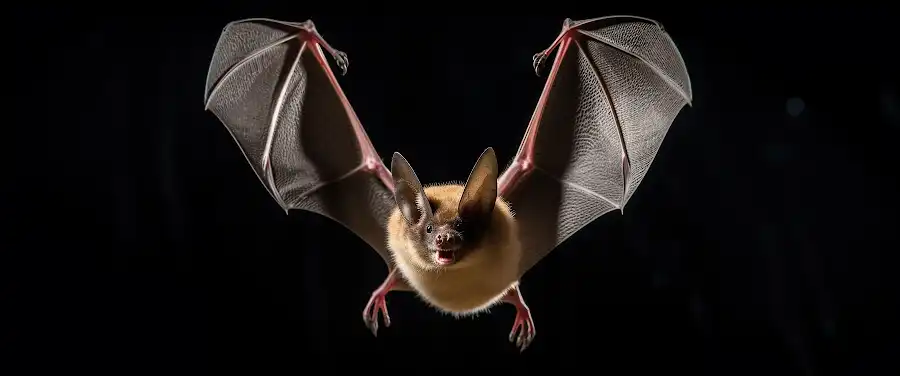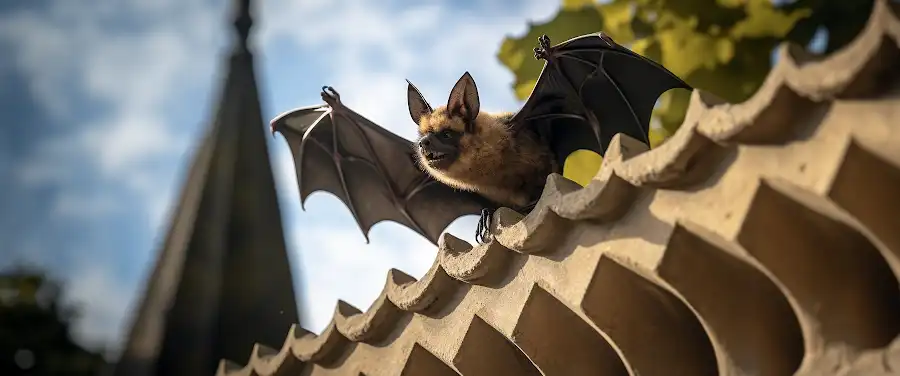
Ever heard that unsettling fluttering in your attic? You know, that soft, almost indistinct rustling sound that could have you mistaken it for the work of a tiny unseen specter. But after a quick inspection with a handy flashlight, you’re faced with a far more tangible, albeit uninvited guest. Bats! Truthfully, bats are amazing creatures, possessing abilities humans can only marvel at. But when they decide your home is also their home, things can get a tad tricky.
In several urban areas, bat infestations have become quite the distressing phenomena. Unbeknownst to many, these nighttime navigators can sometimes stumble upon human habitats and decide to hunker down, much to the dismay of many homeowners. As harmless as they may seem, they can pose a myriad of problems besides the potential fright induced by their sudden appearance. From the accumulation of unpleasant droppings to the potential spread of disease, bats living too close can escalate into an issue none of us wants ratting our peace.
But before you break out the old tennis racket and start swinging wildly in the dark (which could do you more harm than good), might I suggest a slightly safer and saner solution? That’s right, we’re talking about bat deterrents and repellents. In this friendly chat, we’re going to delve into the magical world of these tools and techniques and how they offer outstanding solutions for chivvying away these winged wayfarers from our homes; without causing them harm, of course. So, hang around, dear reader, as we’re about to unravel the mystery behind the bat deterrents and see how they could be your bat control charm. Now, shall we slide smoothly into our subject of the night and discover why bats, amazing as they are, might find our humble abodes somewhat irresistible?
Why is it Necessary to Deter Bats?

When we think of bats, many of us may picture a harmless creature flying freely in the night, fulfilling their ecological role. However, when these winged creatures decide to settle in our homes or buildings, the picture changes radically. It becomes necessary to deter bats not because they are dangerous or harmful creatures in themselves, but because their cohabitation with humans bears several concerns. These include health risks of bats, potential bat property damage, and, surprisingly, various legalities of bat infestation.
Bats and Health Risks
First and foremost, bats are known carriers of several diseases that could potentially transmit to humans and pets. Among these is the infamous rabies, a viral disease primarily transmitted through the bite or scratch of an infected animal. According to the National Institutes of Health, while not all bats are carriers of rabies, around 1% of bats in the wild are suspected to be infected. When we share our living space with bats, the risk of potential exposure to such diseases increases significantly.
Additionally, bats are host to other diseases like histoplasmosis, an infection caused by breathing in spores of a fungus often found in bat guano. Chronic exposure to these spores may lead to severe respiratory problems.
Property Damage Caused by Bats
Secondly, bats could cause substantial property damage. Their droppings or guano can accumulate rapidly, staining and corroding structures, and can create an awful smell around your property!
Legal Implications of Bat Infestation
Lastly, what many homeowners may not know is that there could be legal implications to having bats in residences. Certain bats are protected species in various countries, meaning it is unlawful to harm or kill them, even unintentionally. Therefore, proper eviction techniques must be implemented, which respect the bats’ natural cycles and laws protecting them.
A quick rundown of why it is crucial to deter bats:
- Health risks.
- Property damage.
- Legal implications.
When we start understanding the impact that bat infestation, often unnoticed, can have on our lives, the importance of effective bat deterrents and repellents becomes very clear. Now, let’s delve into these strategies that can help control unwanted bats. Stay tuned for the next section: ” What is a Bat Deterrent and How Does it Work?”
What is a Bat Deterrent and How Does it Work?

When dealing with an unwanted bat population, bat deterrents present an effective and humane method to control the issue. A bat deterrent refers to strategies, devices, or substances utilized to discourage bats from inhabiting certain areas. These products work by causing discomfort or disorientation for the bats, encouraging them to migrate elsewhere, without inflicting harm. In layman terms, the working of bat deterrents can be explained as creating a bat-free zone by making the areas less suitable for bats to live or visit.
Understanding how bat deterrents work involves recognizing the natural tendencies and behaviors of bats. Bats are predominantly nocturnal creatures and usually depend on echolocation (a high-frequency sound wave process) to navigate their environment. The working of bat deterrents interferes with these tendencies, using sound, light, or repellent substances to effectively distress and displace the bats.
Are There Different Types of Bat Deterrents?
When it comes to types of bat deterrents, there are three main categories: physical deterrents, chemical deterrents, and natural deterrents. Each comes with its own set of pros and cons.
| Type | Pros | Cons |
|---|---|---|
| Physical | Non-lethal, reusable, cost-effective | May require professional installation, can disturb non-target species |
| Chemical | Potent, immediate results | May have undesirable environmental impact, may harm non-target species, can cause an unpleasant odor |
| Natural | Inexpensive, eco-friendly, non-lethal | Inconsistent results, may require repeated application |
Physical deterrents like nets or spikes are installed to prevent bats from landing or roosting. They are non-lethal, reusable, and cost-effective but may require professional installation.
Chemical deterrents might include specific bat repellents sprayed or installed in areas with bat activity. These are potent and yield immediate results, but their environmental impact is often undesirable, and they can also accidentally harm other non-target species.
Lastly, natural deterrents might include natural substances, like essential oils, that bats find disagreeable. They are inexpensive, eco-friendly, and non-lethal. However, their results can sometimes be inconsistent, and they may require repeated application.
While choosing a bat deterrent, it’s essential to consider the advantages and disadvantages of each type and align them with your unique situation and needs. It’s also crucial to ensure that any action taken is in line with local wildlife laws and regulations.
Time to check out some of the most effective off-the-shelf solutions to your bat-problem in the next section, “What are the Most Effective Commercial Bat Deterrents?”.
What are the Most Effective Commercial Bat Deterrents?

When discussing effective commercial bat deterrents, it’s important to acknowledge the variety of options available in the market, providing customized solutions to meet the needs of different situations and environments. The efficacy of these deterrents often hinges on factors like their active ingredients, their method of application, and of course, the specifics of the bat problem at hand.
One popular choice among consumers is ultrasonic electronic repellents. Brands like Ultrasonic Pest Repeller and Cleanrth Advanced Ultrasonic Bat Repelling System continuously receive positive feedback. These devices work by emitting ultrasonic waves perceived as intimidating by bats, encouraging them to vacate the premises.
Customers have praised these products for their user-friendliness and effectiveness. However, it’s worth noting that, according to Bat Conservation International, ultrasonic devices may not have a long-term effect. It seems bats can get used to the noise and ignore it after a while.
Another highly rated product range worth mentioning involves sprays and liquids. Pest Rid, for instance, is an all-natural product that acts as a multi-animal deterrent, proving effective in deterring not just bats but also other pests like rats, squirrels, and raccoons.
Customers have appreciated its long-lasting effect and eco-friendly approach, although some have found the smell unpleasant. Such deterrents often derive their effects from a blend of natural ingredients that bats find offensive, thus prompting them to seek other locations.
So, when evaluating effective commercial bat deterrents, it pays to consider not just the alleged results of the product, but also their longstanding effectiveness, ease of use, cost-effectiveness, breaching the trust of scientific research insights, and bat repellent reviews.
Are Natural Bat Deterrents Effective?
When it comes to natural bat deterrents, a myriad of options is available. However, like their commercial counterparts, the effectiveness of these methods can vary greatly based on several factors.
Some homeowners swear by the use of essential oils like peppermint and eucalyptus. These natural scents disturb the sensitive olfactory sense of bats driving them away. However, such an approach requires regular reapplication to maintain effectiveness. Plus, it’s a cost-effective and eco-friendly option.
Another common method is the use of bright lights or loud noises. Bats are nocturnal and prefer a quiet, dark environment—using high-intensity lights or loud sounds can discourage them from inhabiting an area. However, there could be drawbacks. Lights could increase your electricity bill, and continuous loud sounds could be bothersome for the human inhabitants.
Similarly, the use of wind chimes or aluminum foils can also help in certain cases. These methods rely on the bats’ intolerance for high-pitch noises or reflective surfaces.
Evidently, there are varying advantages to natural methods—they promise minimal environmental impact, safety for inhabitants, and affordability. However, the flip side may be a potential compromise on the level of effectiveness, as some bats could adapt to these deterrents over time.
In conclusion, both commercial and natural bat deterrents have their place when it comes to managing bat troubles. It often depends on the user’s requirement—like budget and severity of infestation—to choose the right solution.
In the subsequent topic, let’s delve into how a homeowner can safely install a bat deterrent. After all, choosing a bat deterrent is only one part of the story. The way it’s applied has a significant role in determining its effectiveness. Let’s discuss this next!
How Can a Homeowner Safely Install a Bat Deterrent?

Installing a bat deterrent can pose several challenges for a homeowner. However, with the right precautions in place, it can be a smooth process. Remember, bats are protected species in many regions and handling them requires specific safety measures to avoid harming these important contributors to the ecosystem or even breaking laws. Here’s a comprehensive guide to help you navigate through the installation of bat deterrents without compromising your safety or the bat’s well-being.
Safety Measures While Installing Bat Deterrents
Adhering to safety measures while installing bat deterrents is paramount. It isn’t just about your well-being, but also about the welfare of the bats that are crucial for maintaining ecological balance. Here are some key precautions to bear in mind:
- Never try to touch or handle bats directly.
- Wear long-sleeved clothes, gloves, and eye protection to prevent any contact with bats.
- Never attempt to install a deterrent when young bats are present as they may not be able to fly yet and could die without their mother.
Guide to Bat Deterrent Installation
Installing a bat deterrent might seem like a daunting task, but fear not, with our simple step-by-step guide, you’ll have it installed in no time. The key is to plan carefully and act mindfully.
- Identify the Bat Entry Points: Bats usually come in through small openings near the roof or eaves. Identifying these points will help determine where to install the deterrent.
- Purchase a Suitable Bat Deterrent: This could be ultrasonic devices, bat nets, or even bat cones. It’s essential to choose a device that won’t harm the bats. A great tip is to check out the website Bat World Sanctuary for more insights about bat repellent devices.
- Install the Bat Deterrent: Follow the manufacturer’s instructions to install the deterrent at the entry points. Avoid direct contact with bats.
- Monitor the Situation: After installation, observe the area to ensure the bats are exiting without becoming trapped or injured.
Remember, carefully implementing these steps will minimize the risks associated with handling bats and help repel these creatures in a humane way. The goal is to discourage bats from residing in your dwelling without causing them any harm.
Installing bat deterrents can seem intimidating, but with these safety measures and simple guide, you should find the process a lot easier. That being said, it’s important to remember that bat deterrents are not designed to harm bats, but rather to control their numbers and prevent unwanted infestations in our homes
Conclusion
When the sun sinks and the evening evolves into darkness, you certainly love the tranquility, but not the disorder that unwanted bats can cause around your dwelling. These nocturnal creatures, known for their notable appetite for insects, also bring with them several potential dangers of bat infestations.
The night dwellers’ droppings, known as guano, can transmit diseases like histoplasmosis, a lung disease caused by the spores found in their feces. Additionally, their scratches and bites carry a risk of rabies, an issue that is fatal to humans if not treated in time.
It’s not all doom and gloom, though. With the benefits of bat deterrents and repellents, it’s possible to repel these creatures humanely and effectively, ensuring they no longer transform your abode into their own.
The use of deterrents is crucial in not just saving your property from the unhygienic condition bats can create but also in maintaining a healthy ecosystem. After all, bats play a key role in controlling pests, so obliterating them isn’t an ideal solution.
Employing effective bat control measures, ranging from ultrasonic devices, bat houses to professional services, depend on individual situations. The key is to make these solutions as safe and humane as possible, to safeguard both bats and humans.
So, as you flick the switch and the spotlight hits the night, remember, you are not helpless in face of a bat infestation. Knowledge about deterrents and repellents equips you to tackle the situation head-on while preserving the delicate balance of our ecosystem.




